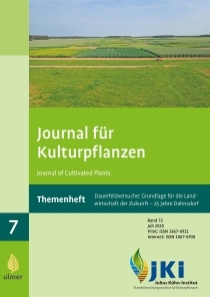On the effects of natural site conditions and agricultural measures on soil organisms – surveys in long-term experiments of the Julius Kühn-Institute in Dahnsdorf (Hoher Fläming, Land Brandenburg)
DOI:
https://doi.org/10.5073/JfK.2020.07.09Keywords:
earthworms, soil microorganisms, organic farming, conventional farming, long-term experiment, winter wheat, tillageAbstract
A high diversity of soil organisms in conjunction with their ecosystem services has a decisive influence on soil fertility and thus crop yields. Earthworms and soil microorganisms are of great importance for the degradation of plant material and thus for the provision of nutrients. Studies on the protection and promotion of these organisms are therefore of central importance in long-term experiments. Findings on the effects of natural site factors and agronomic measures are the focus of these studies. The 5-year results from the long-term experiment of the Julius Kühn-Institute in Dahnsdorf (Hoher Fläming, Land Brandenburg) show that weather and tillage have a much stronger influence on earthworm communities than plant protection measures. The effects of conservation tillage on the two indicator species Aporrectodea caliginosa (endogeic worm) and Lumbricus terrestris (anecic worm) are particularly clear. Furthermore the endo-anecic worm Aporrectodea longa and the endogeic worm Aporrectodea rosea and Allobophora chlorotica have been found but with less abundances. The incorporation of stubble and straw residues into the soil during tillage improves the food supply for A. caliginosa, which reacts with a higher abundance. And vice versa, conservation tillage seems to promote the anectic species L. terrestris, because the food supply on the soil and the preservation of the tubes in the soil benefit this life form. It was well observed that best weather conditions for a high wheat yield were accompanied by an increase in abundance of all species in the following year. Or, conversely, that the extreme drought and high temperatures in 2018 have sustainably reduced the abundance of earthworm communities – regardless of the crop system or tillage. The average number of species and adult earthworms across all life forms and variants is, at 3.0 and 58 animals per m2 respectively, close to the reference value for “arable land on sand” according to Römbke et al. (2012). With regard to soil microorganisms, neither tillage nor the crop system (conventional or organic) have been shown a sustainable change in the activity.
Downloads
Published
Issue
Section
License
The content of the journal is licensed under the Creative Commons Attribution 4.0 License. Any user is free to share and adapt (remix, transform, build upon) the content as long as the original publication is attributed (authors, title, year, journal, issue, pages).
The copyright of the published work remains with the authors. The authors grant the Journal of Cultivated Plants, the Julius Kühn-Institut and the OpenAgrar repository the non-exclusive right to distribute and exploit the work.







